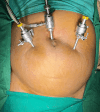Laparoscopic Versus Open Surgical Management of Hydrocele of the Canal of Nuck: A Retrospective Analysis of 20 Cases
- PMID: 38646218
- PMCID: PMC11031193
- DOI: 10.7759/cureus.56584
Laparoscopic Versus Open Surgical Management of Hydrocele of the Canal of Nuck: A Retrospective Analysis of 20 Cases
Abstract
Introduction: Hydrocele of the canal of Nuck is a condition that arises due to incomplete obliteration of the processus vaginalis or an abnormal outpouching from the round ligament during fetal development. It usually presents as a painless, rarely painful, groin swelling. The definitive diagnosis for this condition is magnetic resonance imaging. Various management options have been proposed for this condition, including open surgery, transabdominal preperitoneal approach, totally extraperitoneal approach, and a combination of laparoscopic and open surgery. The present study highlights the benefits of the transabdominal preperitoneal approach when compared with the open anterior approach and addresses the intraoperative challenges faced during laparoscopic surgery.
Materials and methods: The study is a retrospective study inclusive of 20 patients who underwent surgery for the hydrocele of the canal of Nuck from June 2019 to December 2023. Case records of patients were studied for information such as demographic features, type of pathology, the surgery performed, intraoperative challenges encountered, operative time, duration of hospital stay, scores from the visual analog scale pain assessment chart at various intervals, and time taken to return to work. The variables were documented and statistically analyzed.
Results: The average age group of the study population was 27.8 ± 8.34 years. Of the 20 patients, 10 had undergone a transabdominal preperitoneal approach (Group A), and 10 had undergone an open anterior approach (Group B). Eleven out of 20 patients had an associated inguinal hernia, of which three were identified preoperatively and eight were identified incidentally during surgery. The mean operative time of Group A cases was 97.95 ± 7.54 minutes, while it was 66.3 ± 6.20 minutes for Group B cases. The Mann-Whitney U test showed a statistically significantly lesser operative time for Group B than for Group A (p-value < 0.001). The duration of hospital stays was comparable for the two groups with no significant difference (two days versus 3.8 ± 3.08 days, respectively). When the difference in the means of time taken to return to normal work was compared using the Mann-Whitney U test between Group A and B (6.1 ± 0.87 days and 11.2 ± 1.81 days, respectively), a statistically significant early return to normal work in the former group (p-value = 0.001) was revealed. Similarly, the Mann-Whitney U test when used to compare the median postoperative pain score of both groups at 12-24 hours, 48-72 hours, seven days, and three months showed a significantly lesser pain score among patients of Group A at all intervals (p-value < 0.001, p-value = 0.005, p-value = 0.005, p-value < 0.001, respectively). The incidence of intraoperative challenges, sero-hematoma, and surgical site infection were insignificant in comparison.
Conclusion: The transabdominal preperitoneal approach for the hydrocele of the canal of Nuck is ideal as it offers excellent intraoperative delineation of pathology and postoperative outcomes. Prophylactic placement of a mesh in all cases can help prevent a future occurrence of inguinal hernia in these cases.
Keywords: hydrocoele of canal of nuck; magnetic resonance imaging; open anterior approach; processus vaginalis; trans-abdominal pre-peritoneal approach.
Copyright © 2024, Venkateswaran et al.
Conflict of interest statement
The authors have declared that no competing interests exist.
Figures




Similar articles
-
Diagnostic challenges and surgical options for cysts of the canal of Nuck in adults: Two cases report.Medicine (Baltimore). 2025 Apr 25;104(17):e41980. doi: 10.1097/MD.0000000000041980. Medicine (Baltimore). 2025. PMID: 40295299 Free PMC article.
-
Laparoscopic diagnosis and treatment of a hydrocele of the canal of Nuck extending in the retroperitoneal space: A case report.Int J Surg Case Rep. 2014;5(11):861-4. doi: 10.1016/j.ijscr.2014.08.016. Epub 2014 Oct 8. Int J Surg Case Rep. 2014. PMID: 25462052 Free PMC article.
-
Hydrocele of the Canal of Nuck: A report of five cases.Int J Surg Case Rep. 2023 Oct 27;112:108993. doi: 10.1016/j.ijscr.2023.108993. Online ahead of print. Int J Surg Case Rep. 2023. PMID: 39491851 Free PMC article.
-
Hydrocele of the Canal of Nuck: A Review.Cureus. 2022 Apr 2;14(4):e23757. doi: 10.7759/cureus.23757. eCollection 2022 Apr. Cureus. 2022. PMID: 35402114 Free PMC article. Review.
-
Contemporary Review of Masses in the Canal of Nuck.Cureus. 2023 Mar 27;15(3):e36722. doi: 10.7759/cureus.36722. eCollection 2023 Mar. Cureus. 2023. PMID: 37123808 Free PMC article. Review.
Cited by
-
Cyst of the canal of Nuck in an adult female patient: A case report on surgical management.Int J Surg Case Rep. 2025 Jan;126:110807. doi: 10.1016/j.ijscr.2024.110807. Epub 2024 Dec 31. Int J Surg Case Rep. 2025. PMID: 39753066 Free PMC article.
References
LinkOut - more resources
Full Text Sources
